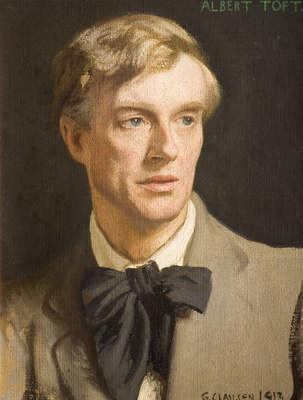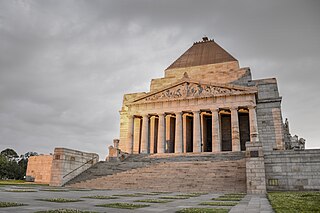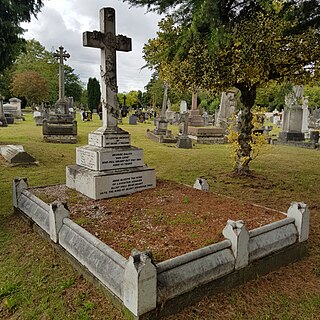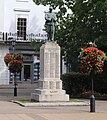
Albert Toft was a British sculptor.

The Shrine of Remembrance is a war memorial in Melbourne, Victoria, Australia, located in Kings Domain on St Kilda Road. It was built to honour the men and women of Victoria who served in World War I, but now functions as a memorial to all Australians who have served in any war. It is a site of annual observances for Anzac Day and Remembrance Day, and is one of the largest war memorials in Australia.

The Royal Artillery Memorial is a First World War memorial located on Hyde Park Corner in London, England. Designed by Charles Sargeant Jagger, with architectural work by Lionel Pearson, and unveiled in 1925, the memorial commemorates the 49,076 soldiers from the Royal Artillery killed in the First World War. The static nature of the conflict, particularly on the Western Front, meant that artillery played a major role in the war, though physical reminders of the fighting were often avoided in the years after the war. The Royal Artillery War Commemoration Fund (RAWCF) was formed in 1918 to preside over the regiment's commemorations, aware of some dissatisfaction with memorials to previous wars. The RAWCF approached several eminent architects but its insistence on a visual representation of artillery meant that none was able to produce a satisfactory design. Thus they approached Jagger, himself an ex-soldier who had been wounded in the war. Jagger produced a design which was accepted in 1922, though he modified it several times before construction.

Groesbeek Canadian War Cemetery and Memorial is a Second World War Commonwealth War Graves Commission military war grave cemetery, located in the village of Groesbeek, 8 km (5.0 mi) southeast of Nijmegen in the Netherlands. Of the total 2,619 burials, the cemetery contains 2,338 Canadian soldiers. It was built to a design by Commission architect Philip Hepworth.

The Sydney Cenotaph is a heritage-listed monument located in Martin Place, in Sydney, New South Wales, Australia. It was designed by Bertram Mackennal and built from 1927 to 1929 by Dorman Long & Co. It is also known as Martin Place Memorial and The Cenotaph. It is one of the oldest World War I monuments in central Sydney. It was added to the New South Wales State Heritage Register on 11 November 2009.

Lambeth Cemetery is a cemetery in Tooting, in the London Borough of Wandsworth. It is one of three cemeteries owned by Lambeth London Borough Council, the others being West Norwood Cemetery and Streatham Cemetery.

The Carnforth War Memorial was erected on 9 November 1924, to commemorate soldiers from Carnforth who died during and after World War I.

Manchester Cenotaph is a war memorial in St Peter's Square, Manchester, England. Manchester was late in commissioning a First World War memorial compared with most British towns and cities; the city council did not convene a war memorial committee until 1922. The committee quickly achieved its target of raising £10,000 but finding a suitable location for the monument proved controversial. The preferred site in Albert Square would have required the removal and relocation of other statues and monuments, and was opposed by the city's artistic bodies. The next choice was Piccadilly Gardens, an area already identified for a possible art gallery and library; but in the interests of speedier delivery, the memorial committee settled on St Peter's Square. The area within the square had been had been purchased by the City Council in 1906, having been the site of the former St Peter's Church; whose sealed burial crypts remained with burials untouched and marked above ground by a memorial stone cross. Negotiations to remove these stalled so the construction of the cenotaph proceeded with the cross and burials in situ.

Southampton Cenotaph is a First World War memorial designed by Sir Edwin Lutyens and located in Watts Park in the southern English city of Southampton. The memorial was the first of dozens by Lutyens to be built in permanent form and it influenced his later designs, including the Cenotaph in London. It is a tapering, multi-tiered pylon which culminates in a series of diminishing layers before terminating in a sarcophagus which features a recumbent figure of a soldier. In front is an altar-like Stone of Remembrance. The cenotaph contains multiple sculptural details including a prominent cross, the town's coat of arms, and two lions. The names of the dead are inscribed on three sides. Although similar in outline, later cenotaphs by Lutyens were much more austere and featured almost no sculpture. The design uses abstract, ecumenical features and lifts the recumbent soldier high above eye level, anonymising him.

Redheugh Gardens War Memorial or Hartlepool War Memorial is a World War I and World War II memorial located in the Headlands of Hartlepool, County Durham, England. It commemorates Hartlepool military servicemen and civilians who lost their lives in both wars – with specific mention of the first British soldiers to have died on British soil during 16 December 1914 Raid on Scarborough, Hartlepool and Whitby of World War I. In 2001 a plaque was unveiled to memorialise 240 men and women who succumbed from 1919 to 1967 during war and conflict.

Rochdale Cenotaph is a First World War memorial on the Esplanade in Rochdale, Greater Manchester, in the north west of England. Designed by Sir Edwin Lutyens, it is one of seven memorials in England based on his Cenotaph in London and one of his more ambitious designs. The memorial was unveiled in 1922 and consists of a raised platform bearing Lutyens' characteristic Stone of Remembrance next to a 10-metre (33 ft) pylon topped by an effigy of a recumbent soldier. A set of painted stone flags surrounds the pylon.

The Imperial Camel Corps Memorial is an outdoor sculpture commemorating the Imperial Camel Corps, located in Victoria Embankment Gardens, on the Thames Embankment to the east of Charing Cross station, in London, England. The unit of mounted infantry was created in December 1916 from troops that had served in the Gallipoli campaign in the Dardanelles.

The South African War Memorial is a First World War memorial in Richmond Cemetery in the London Borough of Richmond upon Thames. Designed by architect Sir Edwin Lutyens, the memorial is in the form of a cenotaph, similar to that on Whitehall, also by Lutyens. It was commissioned by the South African Hospital and Comforts Fund Committee to commemorate the 39 South African soldiers who died of their wounds at a military hospital in Richmond Park during the First World War. The memorial was unveiled by General Jan Smuts in 1921 and was the focus of pilgrimages from South Africa through the 1920s and 1930s, after which it was largely forgotten until the 1980s when the Commonwealth War Graves Commission took responsibility for its maintenance. It has been a grade II listed building since 2012.

Finchley War Memorial is located in Ballards Lane, North Finchley, outside the United Services Club. It was unveiled by Viscount Lascelles on the 13th November 1925, an event that was attended by thousands of people. The memorial is dedicated to 1,000 servicemen and women from Finchley who died in World War I. After the ceremony, dignitaries addressed a tightly packed gathering in the St Kilda Hall. Finchley sent over five thousand men to the Colours. Finchley United Services Club

Runcorn War Memorial was built to commemorate the servicemen of Runcorn lost in active service in the First World War. It was unveiled on Remembrance Sunday 1920 at 3:30pm, beginning a tradition of afternoon services. In 1948, the memorial was rededicated and the names of those lost in the Second World War were added. An inscribed stone was added later with the names of those lost in subsequent conflicts.

The Royal Artillery Boer War Memorial is located on the south side of The Mall in Central London, close to the junction with Horse Guards Road at the northeast corner of St James's Park. Unveiled in 1910, it marks the deaths of the 1,083 soldiers of the Royal Artillery who died in the Second Boer War from 1899 to 1902 It has been a listed building since 1970.

The County Fermanagh War Memorial stands in Enniskillen, County Fermanagh, Northern Ireland. It was originally constructed to commemorate the men of the town killed during the First World War, particularly those serving with the local regiments, the 6th (Inniskilling) Dragoons and the Royal Inniskilling Fusiliers. It was later altered to also commemorate those killed in the Second World War.

Twickenham War Memorial, in Radnor Gardens, Twickenham, London, commemorates the men of the district of Twickenham who died in the First World War. After 1945, the memorial was updated to recognise casualties from the Second World War. The memorial was commissioned by Twickenham Urban District Council in 1921. It was designed by the sculptor Mortimer Brown, and is Brown's only significant public work. The memorial is unusual for its representation of a jubilant soldier returning home. It became a Grade II* listed structure in 2017.
The Bank of England War Memorial, in the internal Garden Court at the headquarters of the Bank of England in the City of London, commemorates the bank's staff who were killed while serving in the First World War and Second World War. It includes a bronze sculpture by Richard Reginald Goulden portraying Saint Christopher carrying the Christ Child. It became a Grade II listed building in 2017. The surrounding buildings of the bank are separately listed at Grade I.






















